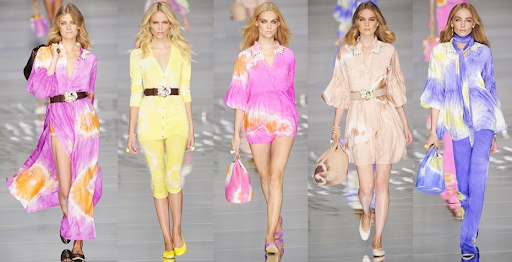Blumarine’s Rebrand Will Make Your Mom Weep
Anna Molinari and Gianpaolo Tarabini established the iconic Blumarine in 1977 in the town of Capri, inspired by the couple’s favorite color and their love of the sea. As the brand expanded, the pair started licensing it to other companies, such as the holding company, Blufin, installed in 1988. Eventually taking its place alongside Italian luxury, the company now sells at more than a thousand retail outlets. Being positioned at the high end of the global market, members of the fashion elite all recognize the brand’s fame and prestige.
However, Blumarine has undergone significant changes since its purchase by Marco Marchi in November 2018. Marchi is the owner of Lui Jo, an Italian fashion company also founded in Capri. At an industry event in Milan, Marchi revealed his intention behind the purchase, “The project to create a holding company and buy another brand stems from the awareness that Italy’s fashion industry has great potential but sometimes is penalized by managerial or financial deficiencies.” Acquiring the totality of Blufin, Marchi expects the annual revenue to expand from 36 million to 55 million dollars in the next five years. However, the first phase of this strategy focuses on the brand’s relaunch with a new creative director.
As of March 2020, Blumarine replaced the creative director Anna Molinari with a much younger talent, Nicola Brognano, hoping to make the label more globally competitive. Brognano boasts an impressive resume, working with the likes of Giambattista Valli and Dolce & Gabbana. Marchi believes Brognano will bring the freshness of his creative talent to Blumarine, “[his] innovative approach will give new impetus to such an iconic brand,” claiming that, “I find all the characteristics needed for a contemporary interpretation of the codes that established the success of Blumarine in Nicola’s creativity and I am glad that a young Italian designer will be narrating this new chapter of the history of the brand while carrying forward the style attitude of Anna Molinari.”
While Blumarine was previously known for its femininity, sassiness, and attention to flourishing details, Brognano has mainly focused on bringing the fashion house closer to newer generations, flipping and twisting the label’s narrative into a sort of Y2K renaissance. Brognano hopes to reinterpret Blumarine, leaning into its integral identity and character, “Blumarine fashion and the style of Anna Molinari have always represented a personal source of inspiration and a true testimony to creativity and vision.” Yet, when asked backstage about his inspiration for his most recent collection, he claimed, “No one in particular really.”
The Blumarine Spring/Summer Season 22 Collection launched this past week on September 23rd at Milan Fashion Week. The looks were described as “skimpy, hotter-than-hot,” and “sexed-up,” featuring fringed and beaded bikini bottoms covered by cropped cardi trimmed in regenerated mink or crocheted in fluoro recycled poly and see-through chiffon cargo pants with midriff-baring matching tops in eye-popping DayGlo colors. Blumarine’s stylist, Lotta Volkova, characterized her take on the collection as “Military Fairies. Sexy Butterfly girls. Frivolous and fun early Y2K mood when social media wasn’t on the horizon. Denim patchwork queens. Trippy, psychedelic, neon girls. Red carpet denim prints, red carpet bandanas. Low-waisted mermaids.”
However successful, this new rebrand begs the question, should fashion houses be allowed to evolve from the original print, or are the new heads of this company simply trying to capture Gen Z’s coin? Brognano was quoted in Vogue saying, “I’m inspired by social media, by the girls dressing for real life on Instagram and Tiktok.” Interestingly, in their cover of the Season 22 Collection, Vogue claimed these new pieces will be “snatched up in no time by all the TikTokers and the Dua Lipas of this world.” If this is the target audience Blumarine has in mind, they are right on the money. But is this truly worth sacrificing the integrity of the original brand?
Brognano told Vogue in a February 2021 interview, “My Blumarine is more dirty, bitchy, sexier,” crediting his influence to celebrities such as Paris Hilton and Britney Spears. Brognano hopes that the symbol of the Blumarine butterfly will acquire notoriety similar to Versace’s Medusa. This could be possible when taking into account the feverish migration towards Y2K and considering that, according to Google Trends, an interest in Y2K fashion has increased 190% in the past five years.
All in all, as trends come and go, whether or not Blumarine will be able to extend the longevity of this rebrand is still up for debate. Although, as the average sale price for these pieces has risen +20%, +18%, and +13% since last year, I’m not so sure the brand is concerned with memorializing any remnants remaining from Anna Molinari’s original vision for Blumarine.
Strike out,
Gracie Wipfli
Boca Raton





